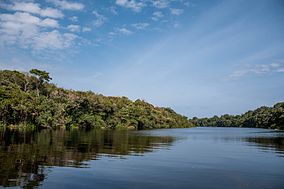Lower Rio Negro Mosaic
| Lower Rio Negro Mosaic | |
|---|---|
| Mosaico do Baixo Rio Negro | |
|
IUCN category V (protected landscape/seascape)
|
|

Anavilhanas National Park
|
|
| Nearest city | Manaus |
| Coordinates | 2°30′32″S 60°57′25″W / 2.509°S 60.957°WCoordinates: 2°30′32″S 60°57′25″W / 2.509°S 60.957°W |
| Area | 7,412,849 hectares (18,317,550 acres) |
| Designation | Protected area mosaic |
| Created | 14 December 2010 |
The Lower Rio Negro Mosaic (Portuguese: Mosaico do Baixo Rio Negro is a protected area mosaic in the state of Amazonas, Brazil. It coordinates between eleven conservation units of different types in the Amazon rainforest to the northwest of the state capital, Manaus.
The Lower Rio Negro Mosaic was established to cover 11 protected area in six Amazonas municipalities: Manaus, Novo Airão, Iranduba, Manacapuru, Barcelos and Presidente Figueiredo, with a total area of 7,412,849 hectares (18,317,550 acres). It contains conservation units in the Amazon rainforest biome in the state of Amazonas. The mosaic is part of the Central Amazon Biosphere Reserve and Ecological Corridor. It covers an area of high biodiversity and high socio-cultural diversity. It includes igapó, terra firma forest, campina, campinaranas, and caatinga-igapós.
The people of the mosaic include traditional riparian communities, indigenous people, artisan fishers, small farmers and gatherers, as well as people involved in tourism, extraction, business and government. Traditional occupations include slash-and-burn agriculture, plant and animal extraction, logging, hunting, crafts and tourism. The local residents have the knowledge needed for sustainable development such as ecotourism, non-timber extraction, agriculture, fishing and other practices.
Creation of the Manaus Free Trade Zone in the 1960s generated intensive population movement into the region and economic growth, and also created social, economic and environmental problems that persist today. Creation of conservation units in the 1980s and 1990s without public consultation caused further conflicts. Many of the traditional residents began to organize and claim rights to access natural resources and territory.
...
Wikipedia

